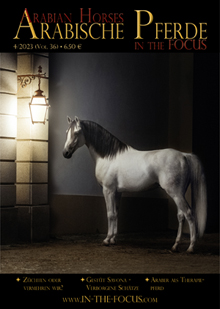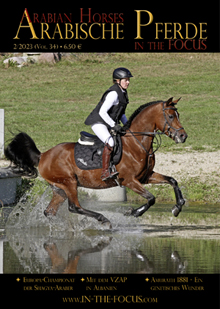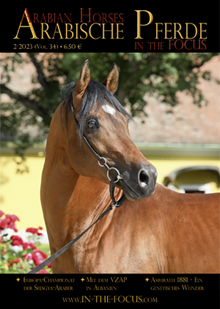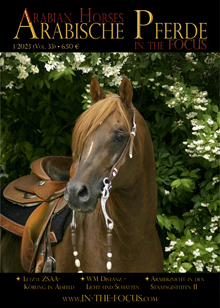The Desertbred horses of Bahrain
Bedouin stories are part of the folklore and history of the Arabian horse. But hardly any breeder of today has a clear image, of how these Bedouin horses actually looked like. On the contrary, the “piece of art”, as we know it from the show ring today, is regarded as the Arab horse par excellence. What a mistake!
[huge_it_slider id=”3″]
Quite often, WAHO Conferences offer opportunities to see and do things, that would otherwise remain unreachable. That was the case ten years ago in Syria, where we could see authentic Bedouin horses of the Anazeh, Shammar and Tai Bedouins in the Al Jazeerah, and that was the case this year, when the WAHO Conference took us to Bahrain. Part of the program was a visit to the Royal Stud and the Stud of Prince Mohammed Bin Salman Al Khalifa. Both studs, which usually are closed to outside visitors, are a refuge for the authentic desertbred Arabian horse.
The Strains of Bahrain
The history of the desertbred Arabian horse in Bahrain is just over 200 years old, which is the time when the then ruling Al Khalifa family came to Bahrain. The history of Bahrain, however, is much older, as the island was first populated some 5000 years ago.
Today’s horses of the Royal Studs trace back to horses of the Al Khalifa family, who came to Bahrain in 1783. Previously, the Al Khalifas belonged to the Anazeh Bedouins, whose original home was the Southern Nedjd. Due to climatic and economic changes, they were forced, together with other Bedouin tribes, to leave the Nedjd and move towards the Gulf coast. Parts of several tribes formed a new confederation, one of which was called the Al-Utub, or “Banu Utub”, the tribe of Utub. This tribe populated Qatar, later on Bahrain and Kuwait.
Under the rulership of the Al Khalifa family, Bahrain developed into a centre of pearl fishing and gained a certain prosperity. Due to the close proximity to the Arabian mainland, yet still isolated as an island, Bahrain often became the refuge for Sheikhs from Saudi Arabia and with them for their war mares, some of which founded a damline here. When and how each of these damlines came to Bahrain, cannot be ascertained, and some were already in the ownership of the Al Khalifa family since the dawn of time, meaning, as long as they could remember, others followed later as war booty.
Just like anywhere else in Arabia, some of the mares were especially valued by the Al Khalifas due to their extraordinary characteristics, such as speed, courage or stamina, and placed higher than others who may have belonged to a more famous strain. All in all, there are 20 damlines still present in Bahrain:
Al-Dahmeh, the strain was well established in the 19th century, but was lost in 1928. When King Abdul Aziz Al-Saud heard about it, he send a mare, called Dahmeh El Malek to Bahrain. Also Sheikh Abdulla Jassim Al-Thani from Qatar sent a mare, Dahmeh El Shagara. In the following years the strain was perpetuated through Dahmeh El Shagara.
Al-Hadhfah is a substrain of the Al-Obeyah strain. The foundation mare was Obeyah Um El Ardaf, who came to Bahrain as a present of the Sheikhs of Qatar in the 1920ies. This strain is no longer present in the broodmare band.
Al-Hamdanieh was said to have been one of the most preferred strains of the Al-Saud family in Saudi Arabia. The strain is represented in Bahrain with three families: The Hamdaniehs of the old Bahrain-lines, through Hamdanieh Um Shamy from the Sheikh of Kuwait and through Hamdanieh Johara from the Al-Saud line.
Al-Kray, a strain which (presumably) only exists in Bahrain. The foundation mare was supposed to be wild and courageous, but the strain was lost in the Royal Stud. A private breeder gave one of his mares to the stud, so that the strain could survive.
Al-Krush, also called Kuheilat-Krush, exists in Bahrain since the 1850ies; originally, the strain came from the Muteir Bedouins, others say from the Al Rasheed in Hail (Saudi Arabia).
Al-Ma’anagieh, a widespread strain in Arabia, those horses in Bahrain tail back to two foundation mares, Ma’anaghieh bin Idfa Al-Murra, who came to Sheikh Hamed bin Isa in about 1930, and Casbet El Khel, who came from Kuwait in 1940.
Al-Mlolesh, an older but very rare strain, which can (only?) be found in Bahrain; he can be followed up in the female tail line to ancient times.
Al-Musannah, Sheikh Hamed bin Isa got the mare Musannah Safra Um El Jelit from a relative in Kuwait. Her daughter Musannah Al Hamra was one of the preferred mares of Sheikh Hamed and known for her stamina in endurance races. All representatives of today tail back to this mare.
Al-Obeyah, an ancient strain, that was originally at home with the Al-Jiluwi family of the Al Hasa in Saudi Arabia; this strain is well respected and meant to be especially beautiful.
Al-Rabda, the history of this strain in Bahrain is told around the campfires for over 200 years. Mashan bin Hethal of the Anazeh-Bedouins had a famous mare, Rabda Nazhan, who was said to be the wildest and the fastest. The Sheikh of Bahrain and Abbas Pasha wanted to get her at the same time, but Mashan gave her – against all advise – to Bahrain, for which every wish was to be fulfilled. At the market he saw one of the most beautiful slaves and asked to get him – but it turned out to be the Sheikh of Manama. Instead, he received two ship loads of other goods.
Al-Saqlawieh, this strain was maintained at the Royal Studs by two lines, which tail back to the two mares Saqlawieh Hamra and Saqlawieh Riadh. The latter was bred by Emir Bender bin Sultan Abdul Aziz Al-Saud in Saudi Arabia, who was specialized on this strain, and came in 1964 as a gift to the stud from the Emir of Riyadh, Sulman bin Abdullah Aziz Al-Saud.
Al-Shawafah, this strain has been with the Al Khalifa family since ancient times and is valued as one of the most noble ones, especially the stallions of this family.
Al-Shuwaimeh, an old strain in Bahrain. Unique in its looks and beauty, its representatives can be recognized from far.
Al-Suwaitieh, formerly a strain which was common in North Arabia. The foundation mare in Bahrain, Suwaitieh Kuwaitieh, was given as a gift to Sheikh Sulman in the 1950ies.
Al-Tuwaisah, at the beginning of the last century, two mares of the strain Tuwaisah Atiq, bred by the Anazeh Bedouins in Northern Arabia, were given to Sheikh Hamed bin Isa as a tribute. They were rather small and unimpressive, but with the Bahraini stallions they produced wonderful foals: Like an oyster, unimpressive from the outside, but inside they contain a pearl.
Al-Wadhna, this old strain has unfortunately died out in the dam female line in Bahrain.
Kuheilat Afaas, an old strain held in high esteem, it was in Bahrain from the very beginning.
Kuheilat Aladiyat, around the turn from the 19th to the 20th century, Sheikh Hamed bin Isa was given a Kuheilah mare by the Sheikhs of the Ajman Bedouins, which was known to be especially fast (Al Adiyat).
Kuheilat Jelabieh, the original Kuheilah mare, who later got this name, was bought by Sheikh Abdulla Bin Ahmed at the beginning of the 19th century at the prize of 20 pregnant camel mares. She was supposed to be from Sheikh Jarshan of the Utaibe Bedouin tribe.
Kuheilat Umm Zorayr, a very old strain, who is not much in use in the breeding programs outside Bahrain, although the stallions of this strain were used a lot in the Nedjd of the 19th century.
[huge_it_slider id=”4″]
Bahrainis abroad
It is an old tradition of the Royal Studs, that no Bahraini horse will be sold – only given away as a gift. This tradition is being maintained until our time and this way, Queen Elisabeth II was given two Bahraini stallions in 2013 on the occasion of the Royal Windsor Horse Show by Sheikh Hamad Bin Isa Al Khalifa. These were the 12-year-old chestnut stallion Mlolshaan Mahrous, born 2001, and the 11-year-old grey Tuwaisaan Tha’atha’a, born in 2002.
Poland also received such a royal gift in 2014: Kuhailan Afas Maidaan, from the same strain as the stallion Kuhailan Afas imported in 1931, who also came from Bahrain and who had significant influence on Arabian horse breeding around the world. Through his son Bad Afas and grandson Abu Afas, this line goes straight to Comet, one of the most important Polish stallions, especially as producer of broodmares. His best son was probably Pohaniec, who was sold to Sweden, and became the sire of the stallion Probat, who was leased back to Poland, among other reasons, to re-introduce the Kuhailan Afas line, which was nearly extinct at that time in Poland. It was a great success, Probat became sire of the World Champions Fawor and Piruet, the Polish National Champions Pamir, Gil and Gamizon, several race winners and a number of excellent broodmares, such as Egzotyka. After Fawor and Pamir, things got quiet with this line and so the idea to revive the line with a stallion “close to the origin” was developed. This will not lead to success immediately, but then, Kuhailan Afas also needed three generations, until Comet was born!
Already in the middle of the 19th century, at the time of Abbas Pasha I., the mare Jellabiet Feysul went from Bahrain via Saudi Arabia to Egypt. Five generations later, this line produced the mare Kasida, which was exported by Lady Anne Blunt to England for her Crabbet Park Stud. Kasida’s grandson Kazmeen was of a certain importance as the maternal grandsire of Nazeer, Sheik El Arab and El Sareei.
In 1903, the Khedive of Egypt, Abbas Hilmi I., received the mare Bint El Bahrein, a Dahman Shahwanieh from Bahrain. She as well became a foundation mare of Egyptian breeding and eventually left for England for Crabbet Park. Five generations later, Bint Maisa El Saghira was sold to the US, where she became a broodmare at Gleannloch Farms, and from where her blood was spread all over the world.
Other horses, who left Bahrain over the years, were less influential, e.g. Nuhra, a bay Wadhna mare, who went to England; Thorayyah, a bay Tuwaisah mare, who went to US; Savannah, a chestnut mare of the Dahmeh strain, who also went to US and from there further on to Canada, and Tuwaisaan, a bay stallion who ended up in South Africa, where he was used for endurance horse breeding, but left only seven purebred Arabian offspring.
The Royal Stud
The Royal Stud, which includes presently just over 340 horses, has moved to the premises in Al Roudha only in 1983. In five stables all breeding stock is housed, to each stable belongs an adjacent paddock with sun protection. For the ca. 15 stallions, roundpens and walkers are available, apart from that they are ridden regularly. The horses get bran, barley and oats in the morning, alfalfa twice a day, and in the evening again a mash of bran, barley and oats with dates. It is not necessary to feed any food supplements, except for mineral-salt licks.
Each year, about 40 – 50 foals are born. The youngsters live a happy life during their youth and stay “out in the desert” from one to three years of age. Here, they have huge paddocks, separated according to their ages, with food at one end and water at the other, so that they automatically have to move about. With three years, the seriousness of life begins, and they are going into race training, later – if suitable – also endurance training. Whoever proves successful will have, at the age of six, the chance to be considered as breeding stallion, provided he also fulfills all expectations with regards to conformation, performance and bloodlines. Each year, six to seven new stallions are tested in the stud. The mares go into breeding at the age of five to six years. The goal is preservation breeding, for which races and endurance rides – just like in the old day at the Polish and Russian state studs – are a means for the purpose of testing their health and constitution; there is no selection towards speed. There is no mixing with “Western” bloodlines, not even with Egyptians; the present gene pool remains pure in the sense of preservation breeding.
It is quite obvious, that these horses have an extraordinary good character, they were all led only with a halter and rope – also the stallions, even in the presence of other stallions or mares. Even with the unusual situation during the presentation for the WAHO guests, when additionally wind gusts made them more lively than usual, did the stallions wear no bit and the handlers had no whip – the latter would be an interesting idea for the modern show ring!
The horses were presented in groups according to their damlines (strains). This way one could see – at least in some families – how the mare stamped their offspring and even their grandchildren. Although, this should not be confused with a certain “Conformation Type” of the strain (i.e. Kuhailan or Saklawy type). Where this is true over several generations, it is more likely that a breeder chooses among the fillies the one most similar to the dam, to carry on the damline. It was clearly said, during a presentation at the WAHO Conference, that the conformation of the horse has nothing to do with the strains, as the strain name is perpetuated through the mares. A prepotent stallion can change the phenotype of a strain easily. The stallions are furthermore not chosen from the same family or strain as the mare, most likely to avoid inbreeding.
The Stud of the Prince
The stud of Prince Mohammed Bin Salman Al Khalifa, the late uncle of the king, is managed according to similar principles. The foundation stock of the stud came from the Royal Stud. As a young man, Prince Mohammed asked his father, the Emir Sh. Salman Bin Hamed Al Khalifa, if he could choose some mares for his own breeding program. The father was very pleased about the interest of his son and complied with the request. Today, the stud is in the hands of Prince Mohammed’s son and has increased considerably in numbers. Some of the most beautiful Bahrainis have their origin in this stud. There is also constant exchange of breeding animals between the two studs, to maintain certain lines or avoid inbreeding.
It is quite striking in Bahraini horses that they have clear, dry and strong legs, the tendons are clearly visible, the joints well defined, the hooves are wide. Most have excellent riding horse points, such as a good shoulder, a short (!) back and a strong, long croupe. Their backs actually invite you to ride them! And their depth of the body (girth) was large compared to their relative small size. Hardly any of the horses have a “dish”, most of them have a rather straight profile, but nevertheless they all have expression. Quite noticeable is their “normal” muzzle, with big nostrils, and strong jaws – not the “tea-cup muzzle” as favoured by some Western breeders, and where one doesn’t know, if all teeth will still fit in. The neck was carried by most of the horses nicely and proudly with an arch, noticeable is the “mithbah”, the throatlatch – and all this without any necksweats! It goes without saying that all horses were shown without any make-up and without being clipped – what balsam for the eyes! Striking was also the sex dimorphism, the phenotypical difference in conformation between stallion and mare, a characteristic that is commonly found in many horse breeds, but seems to get lost – at least in the show horse lines – more and more.
Reflection
Whoever decides, to breed Arabian horses, usually has a clear picture, an ideal before his inner eye. This ideal has been shaped by the time in which the person is living and when he got into contact with this breed for the first time. This personal ideal has not necessarily anything to do with the original breed, but is shaped by fashion trends. Therefore, each (new) breeders should go to the origin of the breed, to study the source, before he decides what you want to breed. The WAHO Tour to Bahrain was an ideal opportunity to do so.
Gudrun Waiditschka












